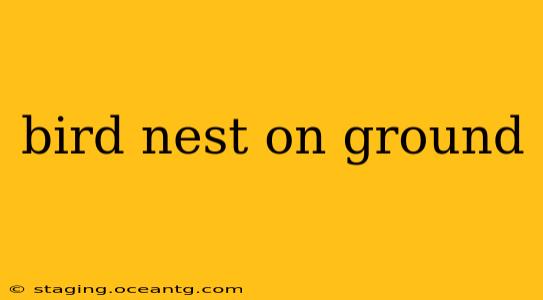Finding a bird nest on the ground can be concerning. While many bird species build nests in trees or shrubs, a surprising number nest on the ground, often for very good reasons. Understanding why a nest is on the ground and how to react to the discovery can help ensure the safety and well-being of the birds. This comprehensive guide will cover everything from identifying the nest to knowing when and how to intervene.
Why is There a Bird Nest on the Ground?
Many people assume a ground nest indicates something is wrong. However, many birds are perfectly adapted to nesting on the ground, choosing it for several reasons:
-
Species-Specific Behavior: Some bird species, like killdeers, plovers, and many waterfowl (ducks, geese, swans), naturally nest on the ground. Their chicks are precocial, meaning they're relatively mobile and independent shortly after hatching. Ground nesting provides easier access to food and shelter for these young birds.
-
Protection from Predators: Ironically, for some species, the ground offers better protection than a tree. The ground can provide camouflage, making the nest and eggs less visible to aerial predators like hawks.
-
Availability of Nesting Sites: In areas lacking trees or shrubs, the ground is the only available option for nesting. This is particularly true in grasslands, open fields, and coastal areas.
-
Nest Placement for Optimal Temperature: Ground nests can offer better temperature regulation in certain climates, particularly in cooler environments.
What Kind of Bird Built the Nest?
Identifying the bird that built the nest is crucial in determining how best to respond. Consider these factors:
-
Location: Where is the nest located? Open fields? Dense vegetation? Near water? This can narrow down the possibilities.
-
Nest Structure: Is the nest a simple scrape in the ground? A more elaborate cup-shaped structure? The construction style provides valuable clues.
-
Egg Appearance: If eggs are present, their size, shape, color, and markings are key identifiers. (Remember: never touch the eggs).
-
Online Resources: Use online bird guides and field guides with images of nests and eggs to assist in identification.
What Should I Do If I Find a Bird Nest on the Ground?
The best course of action is often nothing. Many ground-nesting birds are quite adept at protecting their nests and young. However, here are some guidelines:
-
Observe from a Distance: Avoid approaching the nest closely. Your presence could scare the parents away and make the nest vulnerable to predators. Use binoculars for a better view.
-
Keep Pets Away: Cats and dogs are significant threats to ground-nesting birds. Keep your pets on a leash and away from the nest area.
-
Do Not Touch the Nest or Eggs: Human scent can attract predators, and touching the nest or eggs can easily damage them.
-
Protect the Nest: If the nest is in a highly trafficked area, consider subtly placing a barrier or warning sign to alert people to its presence.
Is the Nest Abandoned?
Determining whether a nest is abandoned can be tricky. Absence of adults doesn't automatically mean abandonment. Parents may be foraging for food or actively hiding to avoid detection. Signs of abandonment may include:
- Dead or decaying chicks or eggs: This is a clear indication of abandonment or loss.
- Eggs that have been significantly damaged or broken: This is also a sign that something has gone wrong.
- No parental activity observed after several hours of observation: While not definitive, lack of parental presence over extended periods can suggest abandonment.
When Should I Intervene?
Intervention should only be considered if the nest is in immediate danger, such as from a physical threat (e.g., construction, flood) or if there is clear evidence of abandonment and the chicks are in immediate danger. Contacting a local wildlife rehabilitation center or bird rescue organization is the best course of action in such situations.
Frequently Asked Questions (FAQ)
What should I do if I accidentally disturb a bird nest on the ground?
If you accidentally disturb a bird nest, quietly and carefully move away. Do not attempt to 'fix' the nest or reposition it. The parents will likely return if they feel safe.
How can I protect ground-nesting birds in my yard?
Avoid mowing grass around nesting sites. Keep pets away from potential nesting areas. Plant native vegetation to provide cover and nesting sites for birds.
Are ground nests more vulnerable to predators?
While some ground nests are vulnerable to predators, many species have evolved strategies to minimize this risk, such as camouflage, nesting in dense vegetation, or distraction displays.
By understanding the natural behavior of ground-nesting birds and following these guidelines, you can help ensure the survival of these fascinating creatures. Remember, observation and responsible action are key to protecting wildlife.
